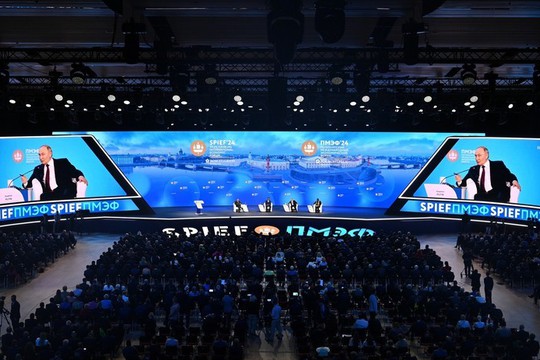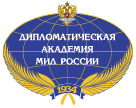Despite the treacherous winds and relentless downpour, 24,200 visitors from 144 countries and territories arrived at the St. Petersburg International Economic Forum for its 28th edition. Compared to the 27th edition, which attracted 21,300 participants from 139 countries, this increase, while slight, was distinctly felt on the ground. As for now, the audience remains largely domestic, although small clusters of Africans, Asians, and Westerners could be spotted sporadically.
Futuristic Expo
The sleek, avant-garde, and spiffy display halls proved once again that the Roscongress Foundation is a leading player in event management. The generosity of some exhibitors noticeably paid off in the form of snaking queues for free t-shirts and what looked to be a vending machine for free gifts—similar to paying gumball dispensers seen in malls. The creative businesses had out a palette of marketing stunts to generate buzz for brand visibility, including a punching bag for anyone ready to flex and impress, an indefatigable athlete clocking uniform strides on a treadmill, and wooden cube puzzles that promised instant rewards for successful solvers.
Moscow and St. Petersburg are quick to pop to mind whenever Russia is mentioned to foreigners, but SPIEF reminds us that the vast motherland beholds far more beyond these two twin cities. Among the Russian regions showcased were the special economic zones of the Caspian Cluster. Situated within a range of 1000 km from eight countries, the Russian Astrakhan region proffers neither import nor export duty on foreign goods and no value-added tax on the export of goods and foreign goods either. However, as with the sabotage of the Nord Stream pipeline, questions now linger over how Russia would manage the ambitious International North-South Transport Corridor (INSTC) from St. Petersburg to the ports of Iran and India after recent military attacks by Israel and its American backer. How would the planned 7,200-km transport artery be affected as atrocious acts of malice seek to reduce Iran to rubble and threaten the region with a Syria-like refugee crisis?
Meanwhile, the Donetsk People’s Republic, with its 2.2 million people liberated by the Russians from their previous tyrannizing overlord, also promoted its investment potential and a wide range of state support measures, including those for finance, agriculture, and property. A merchant from Lugansk, located 155 km away from Donetsk, was proud and happy to share that post-2022, his company has expanded successfully overseas to the giant market of China. Such direct testament from an SME truly speaks to the value and achievement of SPIEF.
Indeed, the striking expo halls did very well in capturing the attention of the forum attendees; however, their immense appeal—coupled with what some lament as a heavy recycle of speakers—might have inadvertently contributed to the empty seats found aplenty in many of the discussion and panel sessions. That’s not to say the sessions were not useful, as many of the wide-ranging topics were highly relevant, including the return of foreign companies who had left in support of sanctions against Russia, the fight against fakes with Russia’s fledging GFCN (Global Fact-Checking Network) unit, as well as the diverse government initiatives needed to strengthen Russia’s reputation as a place for business and investments—especially when numerous others have raced ahead with leaner structures and trust-inspiring frameworks.
Putin Spurring Russia On
Putin’s plenary session, of course, faced no lackadaisical attendance and was filled as usual to the brim. The conversation was moderated by a Lebanese journalist, a choice manifestly made for built-in subtle messaging—the same could be said of the choice of panelists: high-level representatives from BRICS, ASEAN, and GCC came by way of China, Indonesia, South Africa, and Bahrain to project the optics that Russia is hardly isolated.
Putin set the stage by dismantling the notion that Russia is merely a “gas station.” He reported that Russia’s non-oil-and-gas GDP grew by 7.2 percent and 4.9 percent in 2023 and 2024, respectively, to exceed the country’s overall GDP growth rates. The Russian leader sturdily drove across the point that Russia has gone beyond the exports of hydrocarbons to achieve new thresholds in economic diversity and proudly lauded the industries of agriculture, manufacturing, construction, logistics, services, finance, and IT.
Putin went on to share that Russia now ranks as Europe’s number one economy and the world’s fourth largest. The president, however, took care to stress that all economic indicators must be given due attention for what he cautiously advocated as balanced growth.
Although Russia attained the status of a high-income country not too long ago, Putin humbly acknowledged that the nation is not yet a high-wage economy. He extrapolated that job quality can be improved by creating more attractive jobs that align with new technological realities and expressed confidence that these measures will in turn lead to higher labor productivity.
Fulfilling his promise made at SPIEF 2023 to develop a new university ranking system that focuses not on prestige but on the real professional prospects of graduates, Putin announced the scheme’s release to the appreciation of students, parents, and employers. Traditionally prestigious colleges, on the other hand, now find themselves facing competition from regional universities whose graduates are highly sought by employers in particular industries.
This interesting undertaking reveals a strategic Putin who demonstrated he has other methods of turning a game on its head, even if the archaic and impeding bureaucracy in Russia seems too arduous to dismantle. If Putin goes beyond tackling apathetic school management to other government services vital to the propulsion of a modern economic engine—the issue of low wages aside—there is little reason why Russia can’t attract more foreign specialists to its burgeoning labor market.
On geopolitical matters, Putin staunchly and rightly defended Iran’s rights to peaceful nuclear energy, signaling Russia is not afraid to uphold its independent stance even as it seeks to revitalize relations with the United States. If Putin does decide to mediate between Iran and Israel, and does so with success, it would not only restore Russia’s standing in the Middle East but highlights its soft power prowess to the global audience while challenging America’s monopoly in the peace process. The visit of Iranian Foreign Minister Araghchi to Moscow, along with Russia’s condemnations of US attacks on Iran’s nuclear facilities, could very well produce better fruits on coordination than previously achieved.
Shared Values in a Multipolar World
A total of 1060 agreements totaling 6.3 trillion rubles were reportedly signed at SPIEF 2025. These figures sit behind last year’s numbers, but not by much. This suggests Russia has managed to sustain its momentum not only in reorienting itself towards non-Western partners but also in building upon the multipolar effect it spurred after riding upon America’s foolish destruction of the dollar. This recalibration led by Russia and like-minded partners like China does not only benefit its drivers but also the larger world if the synergistic approach keeps in focus mutual respect, shared interests, and economic diversification.
It is also for this reason—and the fact that it has lost its proxy battle in Ukraine—that the United States will now play nice with Russia to draw the latter away from the Chinese orbit. However, given how much Russia—at least its leaders—has matured over the past three years to wean itself off Western validation, the American gestures might have arrived too little and too late.
read more in our Telegram-channel https://t.me/The_International_Affairs

 12:22 23.06.2025 •
12:22 23.06.2025 •























